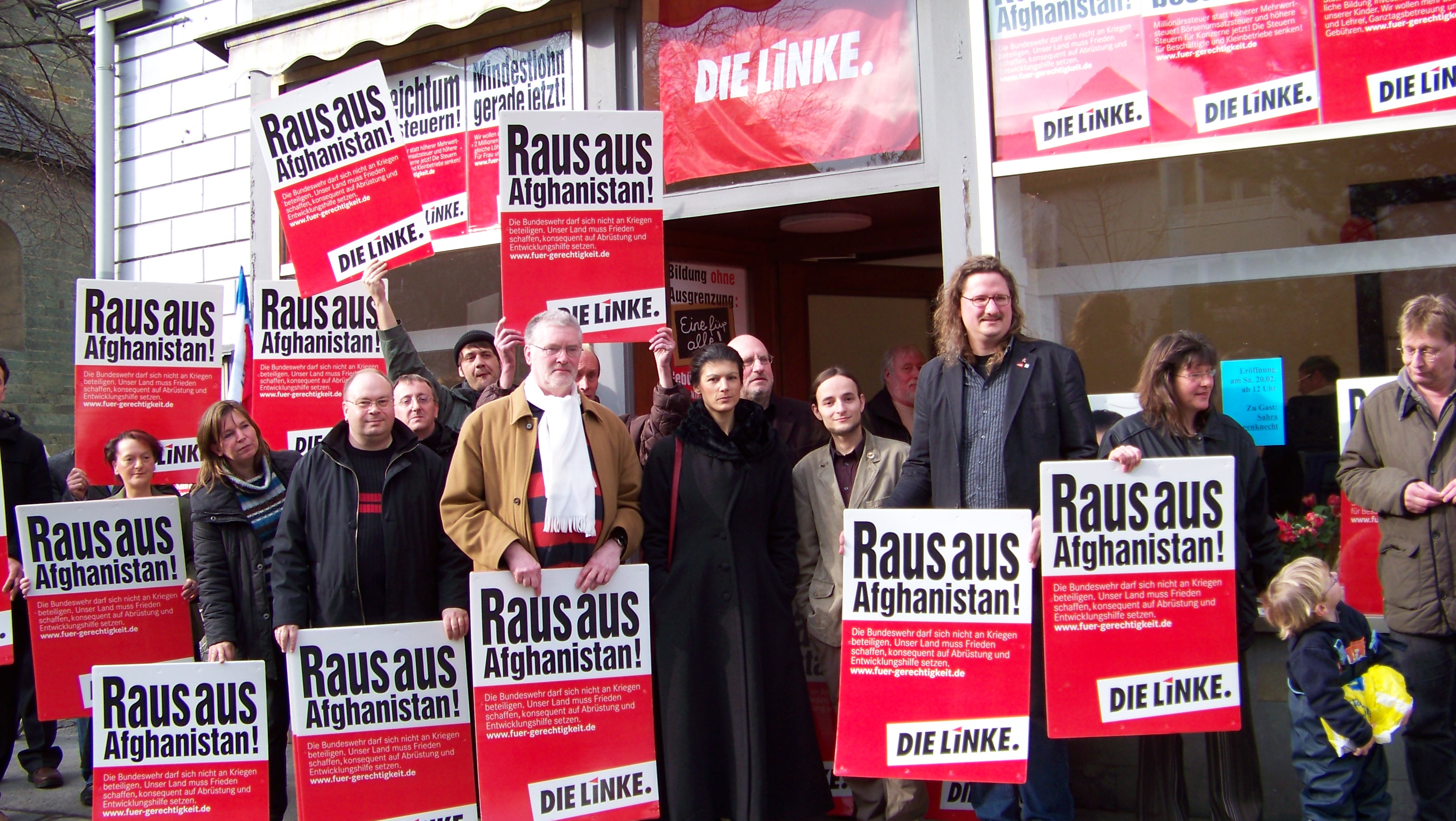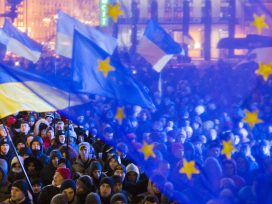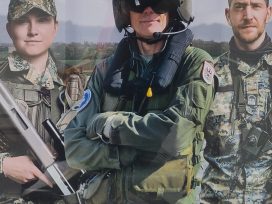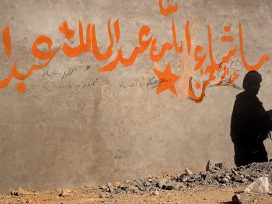How Right is the Left?
The German radical Left in the context of the ‘Ukraine crisis’
In 2014 Ukraine suddenly became a major focus of the western radical Left. The subsequent degree of overlap between radical-left and far-right interpretations and activities of the events in Ukraine has been striking. How to explain this? A good place to start, argues Kyrylo Tkachenko, is Germany.
The ‘Ukraine crisis’ and the reaction on the Left
By reading the most serious leftwing newspapers in Germany or by listening to the speeches of the most prominent leftwing politicians there, one would learn the most curious things about Ukraine. For instance, the Maidan attracted an ‘anti-Semitic ultra-right mob’ which was about to create ‘ethnically liberated zones’;1according to new Ukrainian legislation, the Russian language was forbidden;2there was an increase in anti-Russian violence in Ukraine;3the ‘regime change’ in Ukraine was financed by 5 billion dollars from the USA;4there is an institution to train political activists in Ukraine which is named after Joseph Goebbels;5the Ukrainian trident state symbol is a Nazi symbol;6and so on, and so on.
This is just a selection drawn from newspapers with a print run of over 10,000 copies, and from the comments of leading politicians from Die Linke. Statements of this kind are not quoted out of the context; on the contrary they are quite representative. Even in Jungle World, the most anti-Stalinist and Russia-critical among the largest German leftwing newspapers, we can find statements like ‘Crimea is as much Russian as Lower Saxony is German’.7If we go to the next level down, we encounter still greater absurdities about Ukraine, from repetition of the classical topoi of Russian chauvinism that Ukraine is not a ‘real’ country and Ukrainian is not a ‘real’ language,8to the revelations that there has been ethnic cleansing of Romanians in Ukraine or that ‘in reality’ the Maidan was organized by ‘Zionists’.9
Of course, there have been some notable exceptions, but these have remained minority voices which have barely influenced the general trend. For instance, a scene during the last party congress of Die Linke, in June 2017, was quite telling. A proposal to condemn the annexation of Crimea and Russia’s involvement in the war in the Donbas was not only dismissed overwhelmingly; the vote to do so was received with applause, some of it standing.10This scene is emblematic. If one takes a closer look at initiatives like the picketing of the Russian embassy in Berlin during the late stages of the siege of Aleppo, one can observe many infuriated voices from the Left, condemning it as a ‘Russophobic action’ which had nothing to do with peace efforts11At the same time, one will look in vain for any visible leftist participation in this case or any similar action. One can learn a great deal about leftwing support for the self-proclaimed ‘antifascists’ in the Donbas, but it is hard to find anything supporting the territorial integrity of Ukraine, solidarity with inhabitants of Aleppo, or homosexuals being persecuted in Russia. Even where it exists, it is typically relativized by the ‘but’ clause in the very same sentence. There are dozens of similar constellations, which in sum yield not an assemblage of individual unrelated instances, but a coherent picture of an undeniable and clear trend among the German radical Left.
It is important to emphasize this, because there is an argument that the Left is simply a broad and multifaceted movement, so any generalisations about the alleged dominance of pro-Russian viewpoints are incorrect. Typically, this argument is advanced by people like those who came up with the proposal that was declined during the Die Linke congress. Nevertheless, these people stay in the party and still take part in demonstrations in which banners like ‘Thank you Russia for the liberation of Aleppo!’ are tolerated, and read newspapers in which the worst Stalinist crimes are denied.12
In summary, the German radical Left has accepted the Russian master narrative about Ukraine, including the most blatant propaganda lies. At the beginning, many people (including this author) supposed that this was just an aberration, albeit deplorable, and one subject to correction by factual critique. But four years on from the beginning of the Maidan, it is impossible to avoid the conclusion that this impression was wrong.
No German leftwing newspaper ever apologized for spreading so many lies about Ukraine, although the great bulk of them could have been avoided by simple fact-checking (even without any knowledge of Ukrainian or Russian).
Dietmar Bartsch, the co-chair of the Die Linke faction in German parliament, has never withdrawn his statement that there is an institution to train political activists in Ukraine which is named after Joseph Goebbels. Moreover, he was never admonished, at least not openly, by his colleagues from the party. The allegation that the Maidan was financed by five billion dollars from the US, made by another Die Linke co-chair, Sahra Wagenknecht, during parliamentary debates, is still to be found on her official website, without any comment.13The statement is simply a lie produced by the Russian propaganda machine, still circulating in the leftwing milieu despite being comprehensively refuted.14
To the best of my knowledge, nobody from Die Linke has ever apologized for calling the Ukrainian trident a ‘Nazi symbol’.
As of the beginning of 2018, basically nothing has changed since 2014. The item on the agenda of Die Linke which demands the dissolution of NATO and the creation of a collective security system with the participation of Russia remains unchanged despite Russia’s redrawing of borders by means of war.15
The pro-Russian stance goes so far that another prominent member of the party, the ex-chairman of its parliamentary faction, Gregor Gysi, can state that it would be better for the rest of the world if Trump and Putin were to come to an agreement about the division of their respective spheres of influence16
whereas another high-ranking representative of Die Linke, Alexander Neu, has denied Russia’s bombing of Aleppo – at a point when Russia had been bombing Syria, more or less openly, for eleven months.17Each time Assad’s regime is accused of using chemical weapons, representatives of Die Linke never tire of casting suspicion on the facts. They demonstrate ‘against the bombing of Syria’ only when the United States threatens to intervene. At the same time, their silence about the bombing carried out by Russia and the regime itself is deafening.
Notwithstanding some remarkable exceptions, the narrative about Ukraine as generally accepted by the German Left can be summarized as follows: Maidan is a putsch financed by the western forces; Ukraine is currently ruled by radical nationalists and fascists; Russia was provoked by western intrusion and was forced to protect itself; even if Russia does support the breakaway ‘people’s republics’, the conflict in the Donbas is an instance of civil war instigated by NATO; Russia never invaded Ukraine; and so on, and so forth. As contradictory as this narrative is, it’s vivacity and even a kind of a peculiar coherence becomes clear in the light of some intrinsic features of the leftwing worldview and its correlation with the relevant agenda of the far right.
‘Geopolitical turn’ and the formation of a new red-brown coalition
To highlight the context, one example is instructive. The Prizrak (Ghost) battalion, fighting for the ‘people’s republics’ in eastern Ukraine was seen by many leftists as a ‘communist’ detachment. Its leader Alexey Mosgovoy was praised as a true ‘antifascist’ and dubbed the ‘Che Guevara of Donbas’ in many newspaper articles, statements, and leaflets produced by the German leftists.18
Another Prizrak commander was invited to the conference in Berlin to speak next to the co-chairman of the Die Linke parliamentary faction.19
In fact, even at the peak of their presence, communists constituted a tiny minority in the battalion.20The majority of Prizrak’s members consisted of rightwing extremists including many hardened neo-Nazis. What is quite telling about western ‘communists’’ presence in the battalion is that many of them became members of Prizrak’s subunit InterUnit, led by the French fascist Victor-Alfonso Lenta and containing other representatives of his Unité continentale, inspired by the writings of Alexander Dugin.21As we can judge on the basis of interviews, photos and videos, while in Prizrak rightwingers did not hide their views and their symbols were omnipresent in the battalion. Nonetheless, in explaining their motivation to join, leftists from western Europe usually cited their wish to be part of the ‘fight against fascism’.22One Spanish communist, for instance, described his indignation at seeing so many ‘fascist emblems’ being used in the Ukrainian army as the main reason for his decision.23
The irony is that the peak of German Left activities in support of Prizrak coincided with the period when the concentration of neo-Nazis in its ranks was at its highest. It was not only several times higher than in the Ukrainian army as a whole, but possibly no less than in the notorious Azov battalion.
We can hold that Prizrak’s supporters knew very well what they were doing, but despite everything continued to do it. They may really have believed that their engagement is truly leftist and antifascist. It is not that all of them were Kremlin agents working for money, or that their attitude was profoundly cynical. On the contrary, it is the very feeling of moral superiority which motivated their engagement despite whatever message may have come from the real world.
What is the cause of this contradiction?
The most significant recent developments in the western radical Left is the ‘geopolitical turn’. It declares itself in taking sides with any regime perceived as anti-western, and especially with Russia. This phenomenon is hardly new, but it has taken on new proportions and even a clearer meaning since the annexation of Crimea.
One immediate explanation is a kind of obsolete ‘leftist’ reflex based on the confusion of the former Soviet Union with modern Russia. Although the confusion itself is not exclusively ‘leftist’ and still forms part of a broader western cultural heritage, this cannot be the whole story. Moreover, this reflex in itself is a kind of a symptom of some intrinsic features of the Left.
The remarkable feature of the geopolitical turn in the western Left is the degree of its overlapping with the agenda of the far-right. Its most obvious appearance is the whole set of unifying concepts of the enemy. Those are United States, NATO, European Union, ‘corrupted’ elites and so forth. Although there are notable exceptions both on the Left and on the Right, anti-Americanism and Euroscepticism became a predominant trend on the both sides. Particularly noteworthy is the general correlation between the degree of anti-Americanism and anti-Semitism. The more anti-Americanism becomes the central part of the worldview, the clearer it shows its anti-Semitic connotations. As judged against the backdrop of the situation in Germany, this applies to the far Left at least as much as to the far Right. It is important not only to state their common enemies, but also to investigate the criteria used for their selection. I would argue that the bonding substance of this construct is anti-liberalism.
This is not solely about hatred of the United States. As we can judge by the German Left, even hardened anti-Americanists were able to change their stance as soon as the White House was overtaken by an outspoken anti-liberal. The fact that this could be justified by some ‘geopolitical’ considerations only attests that the new turn in the western Left is not about geopolitics at all.
The same applies to Russia. For the western Left the country was, under Yeltsin, not an inspiration. The true excitement was triggered first by Russia’s military adventures abroad, justified (and cheerfully accepted by the Left) as a part of the grand battle against western expansionism. The crucial thing is that, both in the case of Ukraine and Syria, Russia fought pro-democratic revolts aimed at bringing down dictatorship and defending civil liberties. It is no accident that the western Left was not moved by the Chechen war, although it was even more brutal than the both the war in Syria and Ukraine and could be somehow defended from the standpoint of international law (as far as Russia, still being an empire, at least acted within its internationally recognized boarders). We can be quite sure that if and when Russia becomes a normal, democratic and peaceful state it will also cease to be an inspiration for the international radical Left.
The ‘geopolitical nature’ of the sympathies and aversions of this new red-brown coalition is determined by the single factor of anti-liberalism. ‘Red-brown alliance’ is not a term which everyone will like. How legitimate it is? The alliance to which I refer is not limited to content-related overlaps, but has reached a degree of coordinated action. German leftists’ support of the rightwing detachments like Prizrak would be just one of many examples for such direct cooperation.
Especially in the case of the ‘people’s republics’ in eastern Ukraine there is a whole range of activities which clearly overstep the measure of merely content-related overlaps.
In the case of Ukraine, the degree of coordination and mingling reached a remarkable level. Those people who figured as ‘international election observers’ during the illegitimate referendum after the annexation of Crimea were for the most part representatives of European far-left and far-right parties (of course they didn’t find anything negative to report).24The biggest faction among pro-Russian so-called ‘peace demonstrations’ in Germany have been Die Linke voters, the second largest being the voters of right-populists Alternative für Deutschland (AfD).25It is noteworthy that the demonstrations themselves have been organized by prominent anti-Semites, which apparently did not hinder even some high-ranking representatives of Die Linke from taking part in them. 26It is not only that one can replace whole paragraphs devoted to Ukraine from far-right newspapers and magazines with those from their leftist counterparts without the readers even noticing the swap: in some cases even the contributors appear to be the same people (like Mark Bartalamai, who simultaneously produces videos and texts about Ukraine for the far-left newspaper Junge Welt and for the rightwing populist magazine Compact).27

Kreis Soest and Sahra Wagenknecht (Die Linke) 20 February 2010. Source: Wiki Commons
In the course of the last three years we have witnessed rightwing conferences attended by leftists and vice versa. The degree of mingling goes so far that some events cannot be ranked properly, as they bring together people from far-right and far-left more or less equally.28The whole craziness of the situation is probably best illustrated by the constellation which could be observed during the Conservative Forum held in Saint Petersburg in March 2015. During this remarkable event, which gathered some of the worst far-right extremists from all over Europe, numerous speakers declared that they represented ‘true anti-fascism’. Outside, at the same time, people who came to protest against the congregation were arrested by the police.29
The ‘Ukraine crisis’ may be the major trigger for the formation of red-brown alliances, but surely not a single common battleground. Even more important in the current context are the activities towards bringing down the European Union, as illustrated by such coalitions as that between leftwing Syriza and right-conservative Anel in Greece, the joint efforts of rightists and leftists during the Dutch referendum on the agreement between EU and Ukraine, the degree of convergence in Euroscepticism exercised by the far right candidate Marine Le Pen and the far left candidate Jean-Luc Mélenchon during the last presidential election in France, or the mingling of anti-immigrant rhetoric and EU-critique by the latest hope of the radical Left, British Labour party leader Jeremy Corbyn.30
Besides Ukraine, other spectacular instance would be Syria. The degree of overlap in support of Assad has been remarkable. In both far-right and far-left interpretation it is the West that is primarily responsible for the war. Especially in this case, hatred towards ‘colour revolutions’ illustrates both the depth of the leftist anti-liberal resentment (sometimes verging on outright conspiracy theories) as well as the racist underpinnings of the self-proclaimed ‘anti-imperialist’ ideology at best. It is not only that in this hermetically closed interpretational framework distant subaltern subjects are paternalized in the worst hypocritical manner, within ‘anti-imperialism’ they simply cannot appear as fully-fledged political actors: as long as they do not content themselves with living under some miserable dictatorship they can only be perceived as puppets of western masterminds duped by some hideous CIA operation.
The relativization or/and outright praising of the Russian military intervention in Syria is just a logical counterpart of the leftist outrage about the alleged western ‘intrusion’. Whereas some prominent leftist politicians claimed that there is no evidence that Russian bombs target civilians or expressed doubts as to whether Assad’s forces ever used chemical weapons, some popular leftist newspapers have cheerfully labelled the capture of Aleppo as a ‘liberation’. 31The degree of overlap with interpretations predominant on the far Right goes so far that in Europe we have already witnessed pro-Assad demonstrations during which some demonstrators raise their fists (as a communist greeting) while others proudly show a Nazi salute.32
In short, the red-brown coalition is not limited to the joint efforts linked to the so-called ‘Ukraine crisis’ and can be observed not only in Germany. Similar trends are visible in Spain, Italy and France: there are certainly more Spanish and Italian communists fighting for the brown puppet ‘people’s republics’ in Donbas. While Die Linke’s Sahra Wagenknecht tends to use more elaborate doublespeak and compromised constructions, which allow her to claim afterwards that she did not mean what she actually said, the French far-left leader Jean-Luc Mélenchon is straightforward enough to demand the summoning of a ‘peace conference’ with the aim of redrawing borders in eastern Europe.33
Shared resentment
The pursuit of a common political agenda is a trend discernible at both extremes of the political spectrum. Though this phenomenon manifests itself primarily through content-related overlaps, I believe there are good reasons to refer to it as a red-brown alliance. Its commonalities are based on shared anti-liberal resentment. Of course, there remain palpable differences between far left and the far right. But we should not underestimate the dangers already posed by these left-right intersections, as well as what we might lose if the resentment-driven backlash becomes mainstream.
This text is a revised excerpt from a book being prepared by the author which will be published by the Krytyka publishing house in autumn 2018.
https://www.freitag.de/autoren/peter-nowak/schutzschirm-fuer-antisemiten-und-ultrarechte
https://www.freitag.de/autoren/vit-jasch/russischsprachige-minderheit-in-ukraine
https://www.jungewelt.de/loginFailed.php?ref=/artikel/215966.antirussische-gewalt-in-der-ukraine.html
http://www.sahra-wagenknecht.de/de/article/2391.die-agilsten-gegner-europas-sitzen-in-br%C3%BCssel.html
https://www.youtube.com/watch?v=2gXkpu4TiBA
http://linksfraktion.de/pressemitteilungen/nato-manoever-nazi-symbolen-sofort-beenden
http://jungle-world.com/artikel/2014/25/50070.html
http://www.linksnet.de/de/artikel/31183
http://www.linkezeitung.net/index.php?option=com_content&view=article&id=17828:zionisten-offenbar-treibende-kraefte-beim-versuch-von-regime-change-in-der-ukraine&catid=82&Itemid=248
http://www.mdr.de/nachrichten/politik/inland/linke-gegen-russland-kritik-im-wahlprogramm-100.html
https://www.facebook.com/WolfgangGehrckeOfficial/posts/236412270114416?pnref=story
For example, this denial of the Great Famine in Ukraine (1932-33) in the newspaper Junge Welt: https://www.jungewelt.de/artikel/312978.der-erfundene-v%C3%B6lkermord.html.
http://www.sahra-wagenknecht.de/de/article/2391.die-agilsten-gegner-europas-sitzen-in-br%C3%BCssel.html
http://www.zeit.de/2015/20/ukraine-usa-maidan-finanzierung/komplettansicht
Wahlprogramm der Partei DIE LINKE zur Bundestagwahl 2017, p. 101.
http://www.watson.ch/!338993216
http://www.deutschlandfunk.de/linksfraktion-ueber-das-bueroversehen-sind-wir-sehr-dankbar.694.de.html?dram%3Aarticle_id=363439
For instance: http://remembers.tv/mord-an-mozgowoj-ein-zynischer-sbu-versuch-den-widerstand-zu-zerschlagen/; http://www.heise.de/tp/artikel/45/45023/1.html; https://www.jungewelt.de/2015/09-12/031.php.
http://www.rosa-luxemburg-konferenz.de/de/unsere-referenten
As corraborated by one of the battalion‘s leaders, Alexey Markov, and the last head of the InterUnit, Italian volunteer ‘Nemo’ (http://www.newtimes.ru/articles/detail/100657/; https://www.youtube.com/watch?v=MGdR8GSRNDc).
http://anton-shekhovtsov.blogspot.com/2014/08/french-eurasianists-join-pro-russian.html
For instance: https://www.youtube.com/watch?v=dVovaPqcG3A; https://www.youtube.com/watch?v=Ba9yspXf6Ac; https://www.youtube.com/watch?v=t0OqHAycOBY; https://www.youtube.com/watch?v=9rCcbhS1BS4; https://www.youtube.com/watch?v=MGdR8GSRNDc.
https://www.youtube.com/watch?v=vpSiXL3DPwA.
http://anton-shekhovtsov.blogspot.com/2014/03/pro-russian-extremists-observe.html
https://depositonce.tu-berlin.de/bitstream/11303/5260/3/occupy-frieden.pdf
A good collection of materials on this topic to be found on the research blog Friedensdemo-Watch (http://friedensdemowatch.blogsport.eu/).
https://linksunten.indymedia.org/de/node/144110; https://matrochka.wordpress.com/2016/08/09/neurechter-journalistendarsteller-im-donbass-mark-bartalmai/.
Some of the most prominent instances of left-rightist conferences: https://linksunten.indymedia.org/en/node/143105; https://linksunten.indymedia.org/en/node/143240; https://linksunten.indymedia.org/en/node/179553; http://reftlight.euromaidanpress.com/2017/01/10/separatisten-nicht-aller-lander-vereinigt-euch-zwei-moskauer-dialoge-der-nationen-im-vergleich-teil-1/.
http://euromaidanpress.com/2015/03/23/russia-hosts-fascist-forum-in-st-petersburg/
https://www.theguardian.com/commentisfree/2017/jul/25/labour-immigration-jeremy-corbyn-attitudes
https://www.jungewelt.de/loginFailed.php?ref=/artikel/299215.aleppo-ist-frei.html; http://morningstaronline.co.uk/a-6e18-Morning-Star-statement-on-the-situation-in-Aleppo#.WYSQWIjyjIX
https://de.qantara.de/inhalt/syrienkonflikt-rot-braune-allianz-fuer-syrien
http://www.francesoir.fr/actualites-elections/presidentielle-vif-echange-entre-hamon-et-melenchon-sur-la-russie
Published 15 May 2018
Original in English
First published by Eurozine
© Kyrylo Tkachenko / Eurozine
PDF/PRINTIn collaboration with
In focal points
- Not epistemic enough to be discussed
- Another lost generation of art?
- A trace of Russia at the heart of Austria
- What makes a humanist kill?
- Something happens, somewhere
- Vertical occupation
- No longer a footnote
- The Ides of March
- Counteroffensive exhibitions
- No peace without freedom, no justice without law
Newsletter
Subscribe to know what’s worth thinking about.
Related Articles

For those who suffered the consequences of Yalta’s division of Europe, the Helsinki Final Act brought grounds for optimism. Today, as Russia’s regressive war on Ukraine reopens old conflicts, it stands as a monument to European modernity.

Artist Marharyta Polovinko’s creativity persisted in a tormented form through her experiences as a soldier on the Ukrainian frontline. The words of a recently called-up fellow creative and young family man provide a stark reminder that the Ukrainian military is buying Europeans time.






